Smoke from the Swan Lake Fire obscures the view of Kenai Fjords National Park’s Exit Glacier on Aug. 23, 2019. The glacier can normally be seen from this visitor pullout established by the National Park Service. (Photo by Yereth Rosen/Alaska Beacon)
National parks located along Alaska’s coast might clear away some trees or even light fires to limit wildfire damage to important resources like visitor facilities, under a plan being considered by the National Park Service.
The plan is for five coastal parks units: Kenai Fjords National Park on the Kenai Peninsula; Glacier Bay National Park and Preserve; Klondike Gold Rush National Historical Park, which includes the Chilkoot National Historic Trail park unit, and Sitka National Historical Park in Southeast Alaska; and Aniakchak National Monument and Preserve on the Alaska Peninsula.
The Park Service is preparing an environmental assessment of the plan and is seeking public input.
The five park units covered by the environmental assessment are much less fire-prone than those in Interior or northern Alaska, such as Denali National Park and Preserve, where lightning-sparked wildfires are common each summer.
Still, every unit in the National Park Service is required by policy to have a fire management plan, said Elizabeth Bella, lead planner for the Park Service’s Alaska region. For efficiency’s sake, the five park units have been grouped together, she said.
The plan under consideration would leave the details up to individual parks, Bella said: “We think of it as more of a programmatic approach to planning rather than specifics.”
The environmental assessment proposes three alternatives for action. The first is a no-action alternative, which would leave some of the parks without comprehensive wildfire plans, in violation of the national policy. The second option is for some “limited mechanical and prescribed fire treatments” to create protective buffers around buildings and facilities.
The third and more aggressive alternative would allow even more clearance of fuels, specifically along Exit Glacier Road in Kenai Fjords National Park and around the Dyea area of Klondike Gold Rush National Historical Park. Under that alternative, treatment in Kenai Fjords could include “cutting, thinning, piling, masticating, and prescribed burning of fuels up to 100 feet from the pavement edge,” according to the environmental assessment.
Prescribed burning is the use of deliberately set and controlled fires to clear out vegetation that might otherwise fuel a bigger wildfire later.
On the Kenai Peninsula, where there are sometimes-large outbreaks of spruce-killing beetle infestations, clearance of dead trees is frequently used as a fire-safety practice.
Prescribed fires are not proposed for Klondike Gold Rush National Park, unless there is special authorization from the superintendent, under the third alternative in the environmental assessment.
“Prescriptive fire is not necessarily the appropriate tool for every location,” Bella said.
Smoke is a consideration in the proposed plan. Some parks have been subjected to smoke from wildfires burning elsewhere that drifts in and diminishes visitors’ experiences.
That was the case in 2019 in Kenai Fjords, when smoke pouring in from the nearby Swan Lake Fire burning in the Chugach National Forest obscured views of glaciers and degraded air quality in much of Southcentral Alaska, creating threats to people’s health.
The Park Service is accepting public comments on the environmental assessment through July 21. Once those comments are in and considered, the goal is to have a plan completed by October, Bella said.
GET THE MORNING HEADLINES DELIVERED TO YOUR INBOX
The post National Park Service drafting plan that might allow fire-prevention work in coastal Alaska units appeared first on Alaska Beacon.

